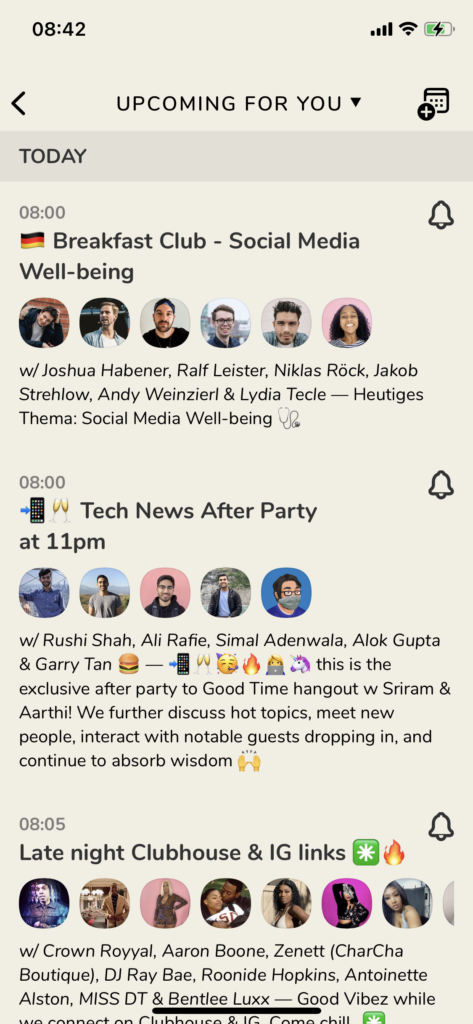
Since last weekend, the news feeds have been bursting with posts about Clubhouse, and Clubhouse is currently topping the app charts as well. But what is actually behind the app, which is already being treated as the next social media hype? We look at how Clubhouse works, what content dominates, and what the criticisms are so far.
What is Clubhouse?
Clubhouse is a new social media platform focused on audio content. As in a kind of live podcast, you can either start topic-related discussion groups yourself in certain rooms, enter other rooms and join in the conversation, or simply listen. You can actively participate by virtually raising your hand and moderators make you the speaker.
The app was launched in the USA in May 2020. Many celebrity users, such as Paris Hilton, Jared Leto, and Ashton Kutcher, quickly gathered there. The app has been making a name for itself in Germany since mid-January 2021. TV celebrities like Joko Winterscheidt, journalist Dunja Hayali and politician Christian Lindner have already taken to the audio app.


How does the Clubhouse app work?
To log in to Clubhouse, you first need the invite of an existing user. Only then are you part of the club and can listen to the much sought-after conversations. Once this hurdle has been cleared, you can create your profile as usual with a picture of your choice and reveal more about yourself in the “Bio” section. You can also link the social media profile on Instagram and Twitter.
During the installation, you will be prompted to follow other profiles so that content can be suggested directly. Likewise, the app queries interests via categories ranging from “Knowledge” to “Tech”, “Sports” or “Wellness”, which are used for further account recommendations.


In addition, the app provides an overview of upcoming talks and displays various notifications. On the one hand, about which users follow you, but also about planned spaces. Moreover, you can meet with your followers alone in a room for ”chatting”. Overall, the functions are therefore manageable. But why is the audio app going so viral right now?


What is special about Clubhouse?
For one thing, Clubhouse is hitting the nerve of the times right now. Through the medium of audio, a feeling of connection and closeness quickly develops – especially when I talk to “allies” about my favorite topics and hobbies. The audio quality is reminiscent of voice messages or telephone conferences, so it stands out from professionally produced podcasts, making it seem more personable and approachable.
In times of ongoing lockdown, when physical events have not been able to take place for a long time, this social exchange is a welcome change from social distancing. At the same time, the inhibition threshold of participation is low, because you can enter the rooms quite informally and leave the room at any time.
Likewise, the principle of FOMO (“Fear of missing out”) plays into the app’s cards, because the content takes place live and cannot be accessed afterwards. If you leave the app, you could miss something exciting and possibly not have a say. Many also want to reap the benefits of being an early adopter, picking up followers and large reach through the hype.
Ultimately, the use is so far reserved for iPhone users and also only possible after an invitation, of which each user can also only distribute a few. Currently, a rather “exclusive” circle is hanging around there and the marketing concept of artificial scarcity is working.


What content dominates on Clubhouse?
At the moment, Clubhouse is often described like an interactive tech conference of the digital scene with creatives, founders and investors. There are discussions, appearances by prominent people and networking dominates. Many voices also compare the social media platform to the beginnings of Twitter.
Admittedly, the app is still operating in quite a bubble at the beginning, but the offer is gradually diversifying. In the future, experts from many different fields will be able to come together there and use this new form of communication for themselves and their niche topics. Freelancers also benefit from networking and sharing experiences.
In addition, you can already find topics far removed from the media industry: watching trash TV together, mindfulness and meditation tips, live DJ sets or murder trivia game shows. So it’s worth diving a little deeper into the app and not being put off by preconceptions.

More and more criticism of Clubhouse
The app, which was founded by Paul Davison and Rohan Seth in Silicon Valley, is raising questions about data privacy because it uses the user’s own phone number and the phone numbers of stored contacts to send invitations. It even creates shadow profiles from it. This has been noticed, among other things, by the fact that profiles of frequently saved numbers, such as the ADAC breakdown service, have appeared.
Also critical: The conversations can be recorded – according to the operators, in order to be able to pursue violations of the Community Guidelines. Another major point of criticism is the lack of moderation and occurring Hatespeech or harassment that is published uncontrolled. Thus, a post by Instagram user @maggietyson_ on this topic, has achieved a lot of attention.
What’s next for Clubhouse?
In the future, the app will be opened to all interested parties. Whether the hype around Clubhouse will last beyond the lockdown and sustainably convince the masses remains to be seen. With increasing user numbers and a growing range of talks, there would have to be more curation and reliable moderation. The app will also have to face data protection criticism. In any case, we will stay tuned and are curious about the further development.
Still have questions about Clubhouse or want to enlist the help of social media experts? We TACSYs are at your service!
Author: Sylvia Muschalski